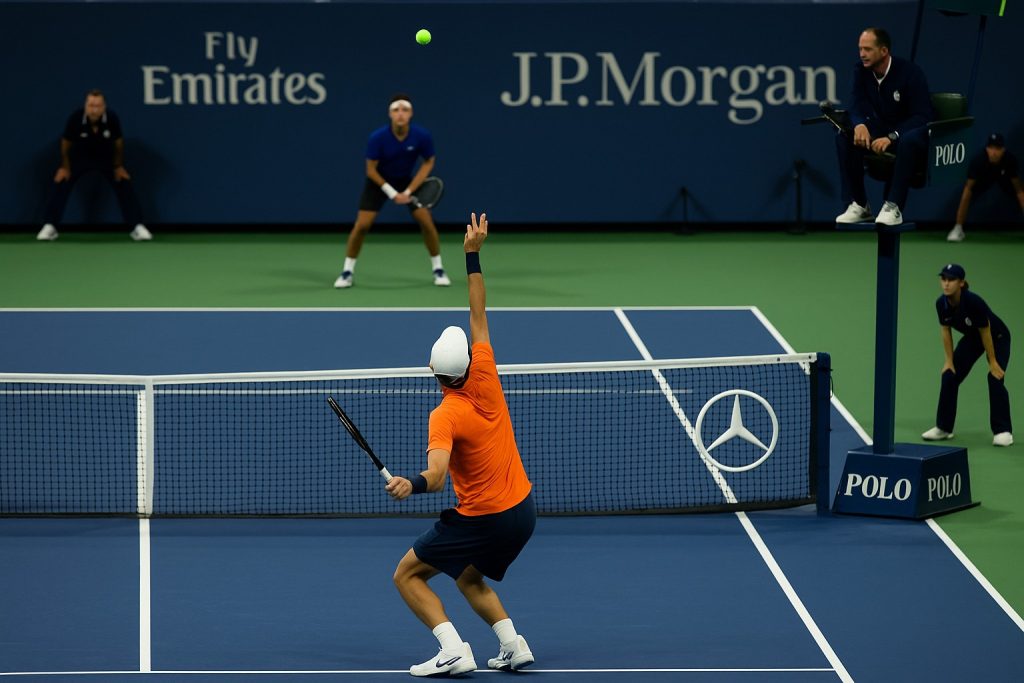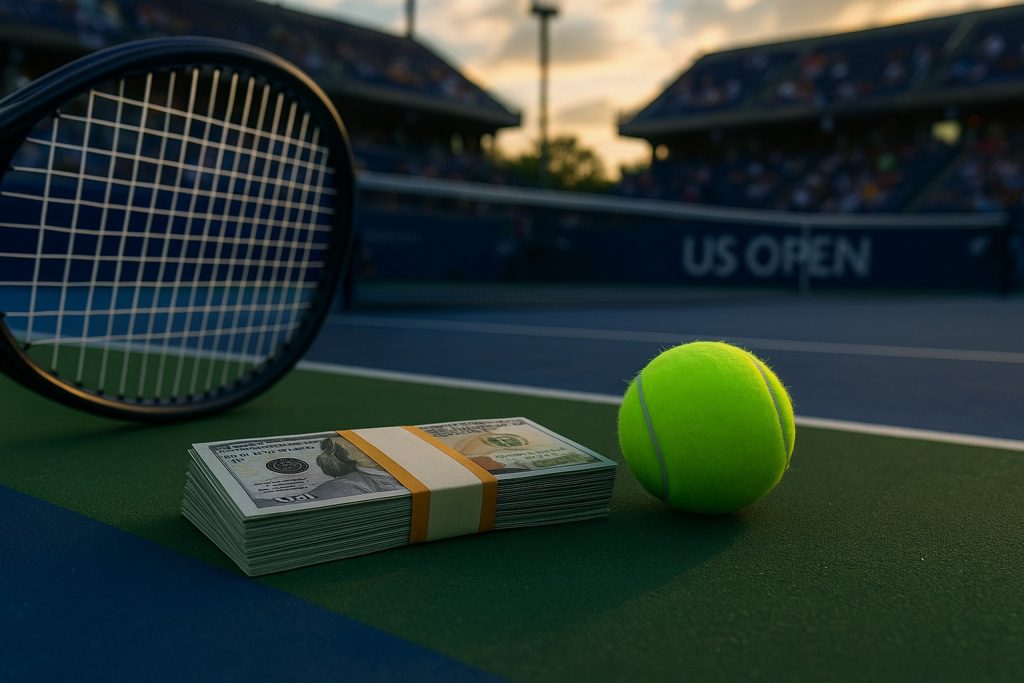Overview
- 🎾 Opening
- 🎾 Key Facts & Changes
- 🎾 Favorites
- 🎾 Rivalries & Storylines
- 🎾 Rising Stars to Watch
- 🎾 Schedule & Broadcast
- 🎾 Prize Money & Points
- 🎾 Venues
- 🎾 History & Records
- 🎾 Tactics & Trends
- 🎾 FAQ
Opening
The US Open has always been more than just a tennis tournament. It is a New York spectacle — loud, crowded, buzzing with energy, and unlike anything else on the tour. In 2025 the event enters new territory: for the first time, play begins on a Sunday, expanding the fortnight into 15 full days. Organizers hope the adjustment not only eases scheduling pressure on players but also gives fans a richer daily menu of matches and entertainment.
Arthur Ashe Stadium, the world’s largest tennis arena, will once again serve as the beating heart of the event. With nearly 24,000 spectators packed under the retractable roof, night sessions here are famous for their electric atmosphere, where the roar from the crowd often lingers long after the final point. For international players, few stages demand both mental toughness and charisma quite like Ashe under the lights.
Beyond the main show courts, the US Open also thrives on its outer courts. Early rounds feature rising stars grinding through long matches just meters away from fans, who can lean against the railings and watch world-class tennis within arm’s reach. The Fan Week preceding the main draw further deepens this sense of accessibility: practices are open to the public, the qualifying tournament is free, and Arthur Ashe Kids’ Day adds a festival spirit before the intensity of competition kicks in.
But the US Open is not just about sport; it is about culture. From food courts representing New York’s diversity to live music and celebrity sightings, Flushing Meadows turns into a city-within-the-city. Players often describe the Open as chaotic but unforgettable — an event where concentration must coexist with the distractions of the Big Apple.
As the last Grand Slam of the year, the stakes are enormous. Momentum for the ATP and WTA Finals, late surges in the rankings, and career-defining breakthroughs all hinge on these two weeks in Queens. Some arrive with pressure to cement legacies, others with the hunger to shock the field and announce themselves on the world stage.
Key Facts & Changes
The 2025 US Open will run from August 24 to September 7, breaking new ground with a Sunday start. This extends the tournament to 15 days, a scheduling move designed to distribute marquee matches more evenly and reduce the late-night finishes that have often been a talking point in previous years.
Another change is the continued standardization of the 10-point tiebreak in deciding sets, now firmly embedded across all Grand Slam events. Introduced to create consistency for players and fans alike, the rule has already delivered drama — and in New York’s charged atmosphere, those extended breakers can feel like a match of their own.
Organizers also confirmed that the official ball supplier remains Wilson, but subtle adjustments in felt and durability have been made to suit the hard-court surface at Flushing Meadows. Player feedback on ball speed and bounce is expected to be a storyline, particularly in the first week when conditions tend to be hot and humid.
On the commercial side, the total prize pool has been raised to $90 million, with singles champions collecting $5 million each — the richest purse in Grand Slam tennis. The increase reflects the US Open’s status as the most lucrative major, reinforcing its appeal not only as a sporting contest but also as a financial pinnacle.
Infrastructure around the USTA Billie Jean King National Tennis Center also continues to evolve. Improvements in fan experience — from expanded food offerings and digital ticketing upgrades to enhanced accessibility on the grounds — underline the Open’s dual identity as both a sporting and cultural festival.
Finally, the Fan Week from August 19–23 remains a core feature, offering free entry to practice sessions, qualifying matches, and the popular Arthur Ashe Kids’ Day. A new exhibition event, the Mixed Doubles Championship, debuts this year with show flair and a winner-takes-all prize of $1 million, aimed at blending entertainment with high-level competition.
Favorites
The US Open 2025 brings together legends, established champions, and new contenders. Both the ATP and WTA fields are stacked with storylines — from veterans chasing history to young stars aiming to seize their breakthrough moments under the New York lights.
ATP Contenders
Novak Djokovic
Country: Serbia • Age: 38 • US Open Titles: 4 (latest: 2024)
Djokovic remains the benchmark. In 2025 he captured both the Australian Open and Wimbledon. His unmatched composure in Ashe Stadium night sessions makes him the man to beat again.
| ATP Ranking | No. 1 |
| Grand Slam Titles | 24 |
| Best US Open Result | Champion (2011, 2015, 2018, 2024) |
| 2025 Highlights | Australian Open Champion, Wimbledon Champion |
Carlos Alcaraz
Country: Spain • Age: 22 • US Open Titles: 1 (2022)
Alcaraz thrives under the lights in New York. His explosive movement and shot variety won him the 2022 title. In 2025 he lifted the Madrid and Paris Masters and reached the Wimbledon semifinals.
| ATP Ranking | No. 2 |
| Grand Slam Titles | 2 |
| Best US Open Result | Champion (2022) |
| 2025 Highlights | Madrid & Paris Masters Champion, Wimbledon SF |
Jannik Sinner
Country: Italy • Age: 24 • US Open Titles: 0
Sinner’s 2025 season includes a French Open final and strong hard-court runs in Cincinnati and Toronto. His booming serve and clean ball-striking make him one of the steadiest threats in the draw. Expect him to aim deeper than ever in New York.
| ATP Ranking | No. 3 |
| Grand Slam Titles | 0 |
| Best US Open Result | Quarterfinal (2022) |
| 2025 Highlights | Roland Garros Finalist, Toronto SF |
Daniil Medvedev
Country: Russia • Age: 29 • US Open Titles: 1 (2021)
Medvedev claimed the Miami Open in 2025 and made a deep run at Wimbledon. His flat baseline game and match stamina suit Flushing Meadows. As a proven New York performer, he should not be counted out.
| ATP Ranking | No. 4 |
| Grand Slam Titles | 1 |
| Best US Open Result | Champion (2021) |
| 2025 Highlights | Miami Champion, Wimbledon QF |
Alexander Zverev
Country: Germany • Age: 28 • US Open Titles: 0 (Finalist 2020)
Zverev is finding form at the right time, with a Canadian Open victory under his belt. His powerful serve and improved consistency make him a dangerous draw at the Open, especially with the wider early schedule aiding recovery.
| ATP Ranking | No. 5 |
| Grand Slam Titles | 0 |
| Best US Open Result | Finalist (2020) |
| 2025 Highlights | Canadian Open Champion |

WTA Contenders
Iga Świątek
Country: Poland • Age: 24 • US Open Titles: 1 (2022)
Świątek dominated 2025 with titles in Rome and Roland Garros. Her consistency and mental edge make her a perennial favorite on hard courts.
| WTA Ranking | No. 1 |
| Grand Slam Titles | 5 |
| Best US Open Result | Champion (2022) |
| 2025 Highlights | Roland Garros Champion, Rome Winner |
Coco Gauff
Country: USA • Age: 21 • US Open Titles: 1 (2024)
Gauff continues to flourish, reaching finals in Madrid and semifinals at Wimbledon. Her supreme athleticism and composure led her to the 2024 US Open crown — a signature moment on her home turf.
| WTA Ranking | No. 2 |
| Grand Slam Titles | 1 |
| Best US Open Result | Champion (2024) |
| 2025 Highlights | Madrid Finalist, Wimbledon SF |
Aryna Sabalenka
Country: Belarus • Age: 27 • US Open Titles: 0 (Finalist 2023)
In 2025, Sabalenka claimed the Australian Open, showcasing her aggressive power game. That style translates well to hard courts. A finalist in 2023 at the US Open, she remains a major threat if she controls the error count.
| WTA Ranking | No. 3 |
| Grand Slam Titles | 2 |
| Best US Open Result | Finalist (2023) |
| 2025 Highlights | Australian Open Champion |
Ons Jabeur
Country: Tunisia • Age: 30 • US Open Titles: 0 (Finalist 2022)
Jabeur’s crafty variety and court sense make her a formidable force. She added the Canadian Open and has consistently threatened deep at Slams. Her elusive style can befuddle the most rigid baseliners.
| WTA Ranking | No. 4 |
| Grand Slam Titles | 0 |
| Best US Open Result | Finalist (2022) |
| 2025 Highlights | Canadian Open Champion |
Jessica Pegula
Country: USA • Age: 31 • US Open Titles: 0 (Quarterfinalist 2022–24)
Pegula’s remarkable consistency has been on display all season, including a final in Rome and multiple Slam quarterfinals. With a nearly flawless 2025 form, she could finally break through in New York.
| WTA Ranking | No. 5 |
| Grand Slam Titles | 0 |
| Best US Open Result | Quarterfinal (2022, 2023, 2024) |
| 2025 Highlights | Rome Finalist, Roland Garros QF |
Head-to-Head Watch
- Djokovic vs. Alcaraz: Tied 3–3 in their last six meetings. Alcaraz beat Djokovic at Wimbledon 2023, Djokovic responded in the 2024 US Open final.
- Sinner vs. Medvedev: A budding rivalry on hard courts. Sinner leads 2–1 in 2025, including a win in Miami.
- Świątek vs. Gauff: Świątek holds the overall edge, but Gauff scored a breakthrough victory in Cincinnati 2023 and then captured the US Open 2024 title.
- Sabalenka vs. Rybakina: Their power duels have become must-watch matches, often decided by a few points in final sets.
Rivalries & Storylines
The US Open thrives on high-pressure rivalries and evolving narratives. These are the matchups and themes most likely to shape New York.
Djokovic vs Alcaraz
The generational duel remains box office. Djokovic’s control and return patterns against Alcaraz’s speed and improvisation produce momentum swings ideal for Ashe night sessions.
Świątek vs Gauff
Contrast defines this rivalry: Świątek’s heavy topspin and early court position versus Gauff’s athletic defense and transition game. A rematch deep in week two is a marquee target.
Sabalenka vs Rybakina
Power on power. First-strike tennis, short patterns, serve efficiency, and tie-break nerve usually decide their meetings by inches.
Sinner vs Medvedev
Geometry versus pace. Medvedev’s deep return position and elastic defense test Sinner’s backhand down-the-line and patience in long, flat exchanges.
American Hopes
Gauff headlines, but Pegula’s consistency, Tiafoe’s shot-making, and Shelton’s lefty serve can electrify home crowds and shake up the draw.
New-Gen Pressure
Rune, Andreeva, and other rising names are expected to convert potential into results. New York’s fast decision cycles expose both composure and flaws.
Rising Stars to Watch
The US Open has always been a launching pad for breakout performances. In 2025, several young players carry both promise and pressure as they try to convert hype into hard results under the New York spotlight.
Ben Shelton (USA)
Age: 22 • Ranking: Top 20 • Best US Open: QF (2023)
The left-handed American’s explosive serve has already turned Ashe into a cauldron. Shelton thrives on crowd energy and enters 2025 with titles in Dallas and Atlanta, making him a dark horse for another deep run.
Holger Rune (Denmark)
Age: 22 • Ranking: Top 15 • Best US Open: R4 (2022)
Rune’s fearless baseline aggression and improving physical endurance make him a dangerous floater. Already a Masters finalist in 2025, he is hunting for his first major semifinal — and has the fire to challenge the best.
Emma Navarro (USA)
Age: 24 • Ranking: Top 25 • Best US Open: R3 (2024)
Navarro has emerged as one of the most consistent young Americans on the WTA Tour. Her tactical patience and composure under pressure earned her a Charleston final earlier this year, raising expectations in front of home fans.
Mirra Andreeva (Russia)
Age: 18 • Ranking: Top 30 • Best US Open: R3 (2024)
At just 18, Andreeva has already reached the second week at multiple Slams. Her maturity and shot variety belie her age, and New York could become the stage where she announces herself as a title contender.
Arthur Fils (France)
Age: 21 • Ranking: Top 40 • Best US Open: R2 (2024)
Fils has the athleticism and shot-making flair that French tennis has been waiting for. A semifinal run in Lyon and several Top-20 wins in 2025 suggest he may be ready for a breakout Slam performance.
Each of these players faces the challenge of balancing expectation with opportunity. The US Open has a history of elevating young talent — from Pete Sampras in 1990 to Emma Raducanu in 2021 — and 2025 may add another name to that list.
Schedule & Broadcast

Prize Money & Points
The US Open 2025 sets another financial benchmark in tennis. With a record purse, it remains the richest of all Grand Slam tournaments, reinforcing its reputation as both a sporting and commercial spectacle.
Grand Slam Comparison
Below is the projected total purse for the four majors in 2025 (in US dollars):
| Tournament | Total Prize Money (USD) |
|---|---|
| Australian Open | $80 million |
| Roland Garros | $75 million |
| Wimbledon | $85 million |
| US Open | $90 million |
Prize Money Breakdown (Singles)
The distribution for singles players in 2025 is as follows (USD):
| Round | Prize Money |
|---|---|
| Winner | $5,000,000 |
| Finalist | $2,500,000 |
| Semifinalist | $1,250,000 |
| Quarterfinalist | $650,000 |
| Round of 16 | $350,000 |
| Round of 32 | $200,000 |
| Round of 64 | $120,000 |
| Round of 128 | $80,000 |
Ranking Points
Grand Slam events provide the highest ranking points outside of the ATP/WTA Finals. Below is the singles breakdown:
| Round | ATP Points | WTA Points |
|---|---|---|
| Winner | 2000 | 2000 |
| Finalist | 1300 | 1300 |
| Semifinalist | 800 | 780 |
| Quarterfinalist | 400 | 430 |
| Round of 16 | 200 | 240 |
| Round of 32 | 100 | 130 |
| Round of 64 | 50 | 70 |
| Round of 128 | 10 | 10 |
Financially and competitively, the US Open sets the standard. The combination of record prize money and maximum ranking points ensures full commitment from every player in the draw.
Venues
The US Open is staged at the USTA Billie Jean King National Tennis Center in Flushing Meadows, Queens, New York. With over 20 courts, it is the largest tennis facility in the world, hosting more than 700,000 fans annually. Its stadiums combine history, technology, and a unique urban energy unmatched in world tennis.
Arthur Ashe Stadium
Capacity: 23,771 (largest tennis stadium in the world)
Opened in 1997 and named after 1968 champion Arthur Ashe, this stadium defines the US Open. Its retractable roof ensures uninterrupted play, while its night sessions generate unmatched electricity. The mix of celebrity courtside seats and vocal fans makes Ashe one of the most intimidating arenas in the sport.
Louis Armstrong Stadium
Capacity: 14,000
Rebuilt in 2018 with a roof and modern design, Armstrong offers a more intimate yet still raucous atmosphere. It is famous for marathon matches and rowdy day-session crowds, often producing some of the tournament’s most memorable battles.
Grandstand
Capacity: 8,125
The fan favorite. Known for its circular seating and proximity to the players, Grandstand offers one of the most intimate Slam experiences. Its lively crowds, especially during early rounds, often turn matches into unforgettable spectacles.
Beyond the stadiums, fans flock to the outer courts for closer access to stars and rising talents. The energy of packed practice courts and the festival-like food village completes the unique US Open experience.
History & Records
The US Open has produced countless milestones since its inception in 1881. It is the only Slam played on hard courts and has consistently embraced innovation — from introducing tie-breaks in 1970 to adopting night sessions and electronic line-calling.
Past Champions
- Men’s Singles: Jimmy Connors, Pete Sampras, Roger Federer, Rafael Nadal, Novak Djokovic — all multi-time champions who defined eras.
- Women’s Singles: Chris Evert, Martina Navratilova, Serena Williams, and more recently Naomi Osaka and Coco Gauff, have left lasting legacies in New York.
Famous Upsets
The US Open often produces seismic shocks:
- 1983: Unseeded teenager Stefan Edberg stunned the field in juniors, foreshadowing his pro success.
- 2009: Juan Martín del Potro overpowered Roger Federer in the final, ending his streak of five straight titles.
- 2021: Emma Raducanu, ranked outside the Top 100, became the first qualifier ever to win a Slam, not dropping a set all tournament.
Historic Milestones
- 1968: Became the first Slam of the Open Era, allowing professionals and amateurs to compete together.
- 1970: First Grand Slam tournament to use a tie-break.
- 2006: Arthur Ashe Stadium introduced night sessions, revolutionizing the sport’s atmosphere.
- 2020: Hosted without fans during the COVID-19 pandemic, marking a surreal chapter in tournament history.
The US Open’s legacy blends tradition and innovation, serving as the sport’s most forward-thinking Slam while honoring over a century of champions.
Tactics & Trends
The US Open is more than a test of talent — it is a laboratory of tactics shaped by surface, conditions, and the city’s unique energy. Hard courts in New York reward explosive first strikes but also demand physical durability over two weeks of best-of-five tennis (for men) and relentless three-set battles (for women).
Court Speed & Conditions
The Laykold acrylic hard court (in use since 2020) plays medium-fast. Late-August humidity can slow the ball slightly during day sessions, while cooler night air often quickens conditions — a boost for big servers and aggressive baseliners.
Serving Power
Dominant serving remains a staple of US Open success. From Sampras and Roddick to Djokovic and Sabalenka, champions consistently control matches behind high first-serve percentages and pressure return games.
Baseline Aggression
Short, explosive rallies are common. Players like Alcaraz and Swiatek use heavy topspin and quick transitions to seize control early, minimizing neutral exchanges.
Mental Endurance
The noise, lights, and unpredictability of New York test composure. Matches often swing on players’ ability to reset between points and embrace chaos rather than resist it.
Emerging Trends
- Return Positioning: More players adopt extreme deep return stances, echoing Medvedev’s success.
- Net Approaches: Younger stars increasingly blend serve-and-volley points to shorten rallies and disrupt rhythm.
- Conditioning: With the 15-day format starting Sunday in 2025, endurance and recovery routines will play an even larger role.
The US Open is as much a mental marathon as a physical sprint. Players who adapt to its tactical demands and psychological intensity often find themselves lifting the trophy in Arthur Ashe Stadium.
FAQ
When are the US Open 2025 dates?
The tournament starts on Sunday, August 24, 2025, and concludes with the men’s singles final on Sunday, September 7, 2025.
Where is the US Open played?
Matches take place at the USTA Billie Jean King National Tennis Center in Flushing Meadows, Queens, New York. Key stadiums include Arthur Ashe Stadium, Louis Armstrong Stadium, and the Grandstand.
Who are the defending champions?
Novak Djokovic (men’s singles) and Coco Gauff (women’s singles) lifted the trophies in 2024 and return as headline contenders in 2025.
How can I buy tickets?
Tickets are available through the official US Open ticket portal. Prices start around $50 for early rounds; premium seats for finals cost significantly more. Hospitality packages are also offered.
Which TV networks and streams cover the US Open?
In the United States, ESPN holds exclusive rights across ESPN, ESPN2, and ESPN+. Internationally, coverage varies: Eurosport/Discovery+ (Europe), TSN/RDS (Canada), Nine/Stan (Australia), and others carry the tournament.
What is the prize money?
The total purse is a record $90 million, with singles champions receiving $5 million each — the highest payout in tennis.
Are there new rules in 2025?
Yes. For the first time, the tournament begins on a Sunday, expanding the schedule to 15 days. The 10-point tie-break in deciding sets remains standard across all draws.
Can fans watch practice sessions?
During Fan Week (August 19–23, 2025), practice sessions and qualifying matches are free and open to the public. Arthur Ashe Kids’ Day also offers family-friendly access.
Is there a Mixed Doubles event?
Yes. The Mixed Doubles competition remains a crowd favorite, while a new Mixed Doubles Championship Event during Fan Week (August 19–20) offers added showpiece value with a $1 million prize for the winning team.

